Pump Handbook by Igor J. Karassik, Joseph P. Messina, Paul Cooper, Charles C. Heald - 3rd edition
Подождите немного. Документ загружается.

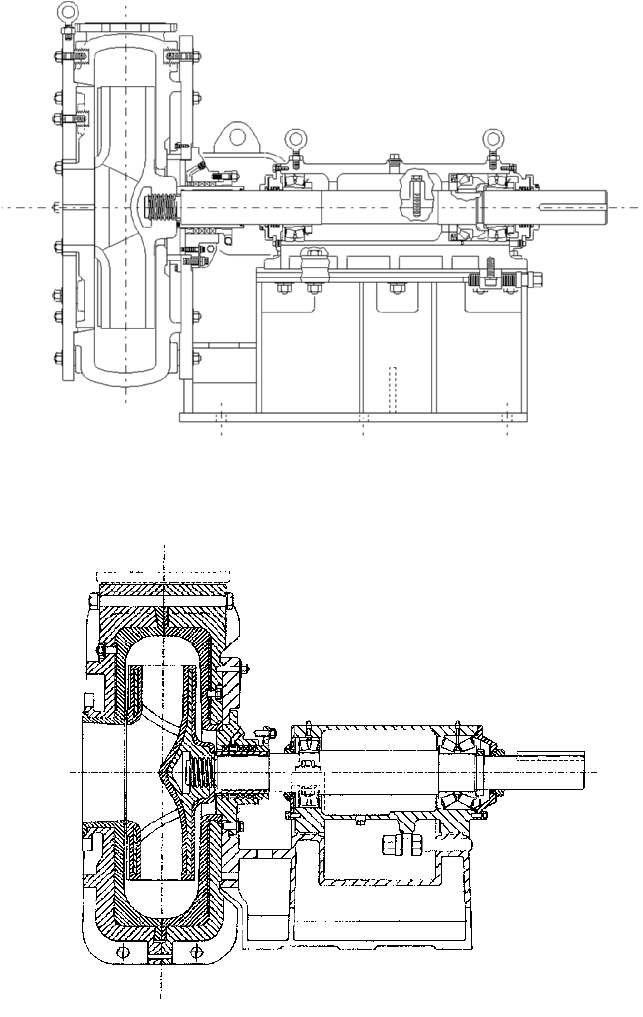
9.354 CHAPTER NINE
FIGURE 3 Typical single-wall hard iron slurry pump
FIGURE 4 Typical double-wall elastomer-lined slurry pump
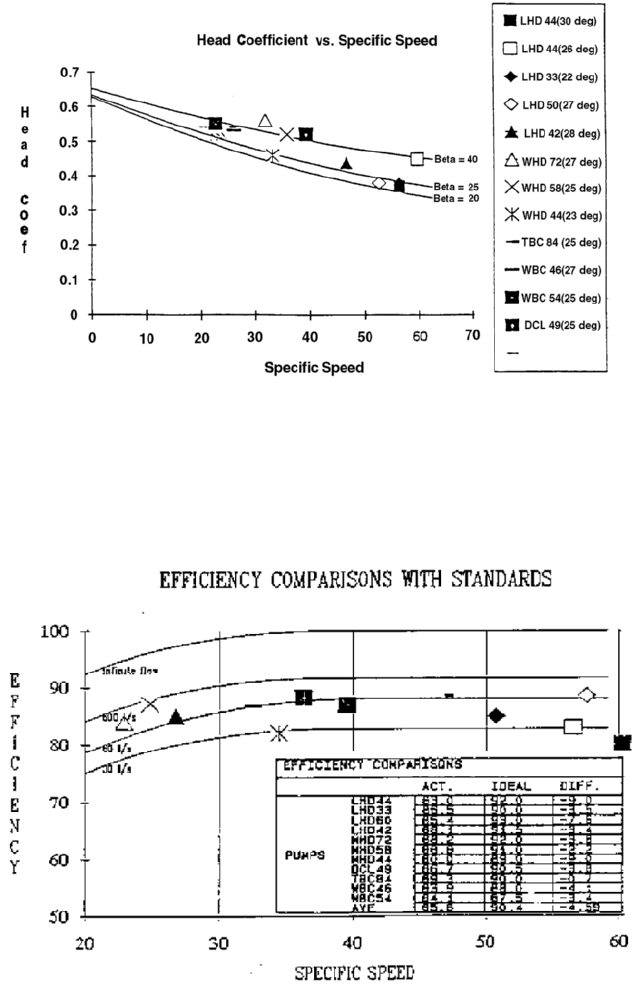
9.16.2 APPLICATION AND CONSTRUCTION OF CENTRIFUGAL SOLIDS HANDLING PUMPS 9.355
FIGURE 6 Pump efficiency as a function of specific speed n
q
, based on m
3
/s, m, and rpm (from Addie and Helmly,
1989). [Note: for specific speed N
s
, based on gpm, ft, and rpm, multiply n
q
by 51.65; for universal specific speed
s
,
divide n
q
by 52.92.]
FIGURE 5 Head coefficient versus specific speed n
q
, based on m
3
/s, m, and rpm (from Addie and Helmly, 1989).
[Note: for specific speed N
s
, based on gpm, ft, and rpm, multiply n
q
by 51.65; for universal specific speed
s
, divide n
q
by 52.92.]
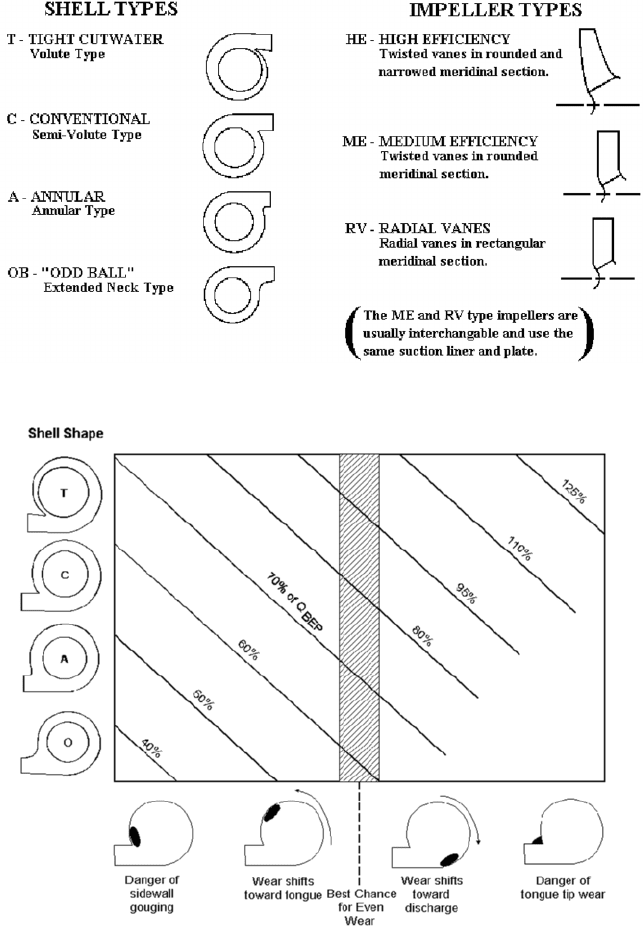
9.356 CHAPTER NINE
FIGURE 7 Types of shells (casings) and impellers
FIGURE 8 Trends in location of casing belly wear
neck intended for limiting wear in the tongue area due to excessive recirculation (which
itself is symptomatic of misapplication). The general applicability of each of these is shown
in Figure 8, taken from Addie and Helmly (1989).
9.16.2 APPLICATION AND CONSTRUCTION OF CENTRIFUGAL SOLIDS HANDLING PUMPS 9.357
Impeller types may be roughly categorized also as being of the old-style square merid-
ional section radial vane RV type (still common in rubber-lined pumps where it is difficult
to mold a twisted vane), the most common rounded rectangular meridional section with
twisted vanes ME type, and the HE type which is closer to a water pump.
Each combination of the types illustrated in Figure 7 has its own hydraulic perfor-
mance and wear characteristics. The HE/T combination generally has the highest perfor-
mance, but is not necessarily the most forgiving for wear, whereas the ME/C combination
is capable of respectable efficiency while at the same time having more predictable wear
performance. In extremely heavy-duty wear service, operation must be at low discharge
flow rates
—
below BEPQ. The A type shell, or even the OB type, could be best for wear
where a pump has been misapplied badly. For additional information on the selection of
different hydraulic types, see Addie et al. (1996).
Impeller and shells using elastomers such as rubber, neoprene, and urethane tend to be
limited to impeller tip speeds less than about 75 ft/s (23 m/s), although this can rise with
stiffer elastomers, at some expense to wear life. Impellers employing elastomers require
higher available NPSH because of the thicker impeller vane sections needed, and this con-
dition may limit their use, for example in pumping flue-gas desulphurization slurries.
MECHANICAL DESIGN OF SLURRY PUMPS ______________________________
Given the distortions noted earlier the mechanical design of a slurry pump is similar to
that of a water pump. Slurry specific gravities (SG) of up to 1.6 and higher may have to be
pumped, so the shaft and bearings of necessity must be more robust. Figures 3 and 4 show
typical pump bearing housings.
Impeller attachment by an Acme-type screw has generally been found best capable of
carrying the heavy loads required, and the connections can be manufactured economically
in the hard materials most commonly employed in impellers. The large loads associated
with heavy-duty service require roller bearings with separate roller thrust bearings.
Designs with ball bearings are suited only for light-service pumps.
The absence of radial sealing in slurry pumps allows shaft deflections larger than those
found in water pumps, and these may limit the life of stuffing boxes and mechanical seals.
Newer and better designs, however, tend to have shorter shafts and smaller deflections,
extending the seal life. A conventional packed stuffing box is still the simplest and most
common rotating-assembly seal. Configurations are similar to those used for water pumps,
with the lantern-ring supplying a clear-water flush to the center for minimum dilution, or
to the product side for maximum life.An expeller-type seal is popular where dilution of the
product is unacceptable. These seals are limited to one stage and involve additional effi-
ciency losses, which usually range to 3% or more.
Mechanical seals are now available that take their coolant from the product and oper-
ate with no clear-water flush; they are mostly of the single partially balanced type. In some
cases, where a pump may run dry, a double type of mechanical seal must be used. At pre-
sent, mechanical seals are the preferred shaft sealing method for fine-particle light-duty
service such as pumps for flue gas desulphurization. These seals are also fairly widely
used in the aluminum industry for red-mud pumping service.A mechanical seal described
in Maciejewski et al. (1993) is used for pumps handling tar sands tailings at pump dis-
charge pressures up to 350 lb/in
2
(2400 kPa), with d
50
about 120 microns and average
slurry density near 0.0578 lb/in
3
(1600kg/m
3
). In this case, the process fluid is at an aver-
age temperature of about 130°F (55°C) and some 0.16 gpm (0.01 l/s) of water is used for
external cooling. In this application, representative of the limits of mechanical seal tech-
nology at the present, the average seal life is about 3000 hours.
As noted before, pump casings made entirely of elastomeric materials have insufficient
strength to withstand the pressure loads, so it is necessary to have an outer casing of some
sort, a configuration that is commonly called a double-wall design. For versatility, some
manufacturers make these designs for interchangeable wetted internal shell components
of hard metal, rubber, or urethane as the service warrants. For very large slurry pumps,
the double-wall configuration is heavy and costly. As a cost-effective design for this case, it
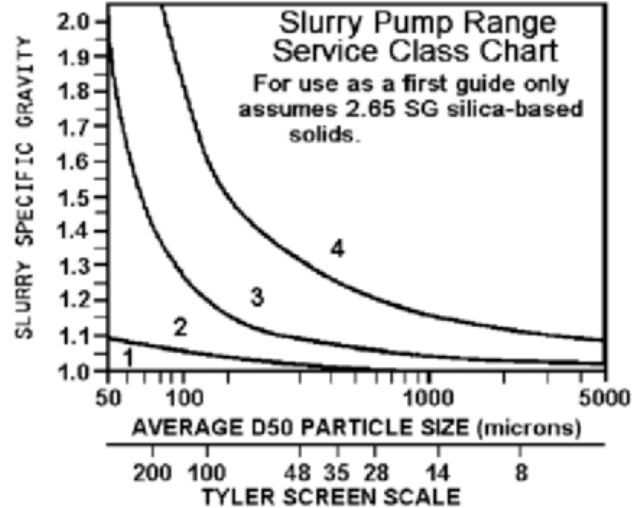
9.358 CHAPTER NINE
FIGURE 9 Slurry pump range service class chart
is worth considering tie-bolt construction using high-tensile outer side plates over a hard-
metal plate and liners as shown in Figure 1.
Further, single-wall designs with the main shell casing in hard metal are simple to con-
struct and maintain and thus are very popular. These can be used unlined or provided
with liners of bonded rubber or other material. Ceramic materials are now available that
are capable of several times the life of both elastomer and hard-metal components. At the
moment, the cost-effectiveness of these materials is such that their use tends to be limited
to areas of high wear and other selected areas of wetted surfaces.
In a shell of single-wall metal design, the wearing components must carry the water
load. Wear tends to progress until leakage of the shell occurs, but the wear is almost
always localized so leakage occurs before the structural integrity of the assembly is
affected. Single-wall designs may easily be ribbed or thickened locally to increase strength
and wear life in a particular area. In small slurry pumps, minimum casing thicknesses
usually produce safe designs of adequate pressure rating.
SELECTION OF SLURRY PUMPS _______________________________________
As noted earlier, service conditions vary significantly, so when selecting a slurry pump, a
recommended approach is to select a service class and limit nozzle (branch) and other
velocities according to that. Figures 9 and 10 from Wilson et al. (1997) outlines an
approach that can be used.
For a given service class, Table 1 provides a guide to maximum impeller, nozzle
(branch), and other velocities that should give reasonable wear life and keep the cost and
size of the pump to a minimum.
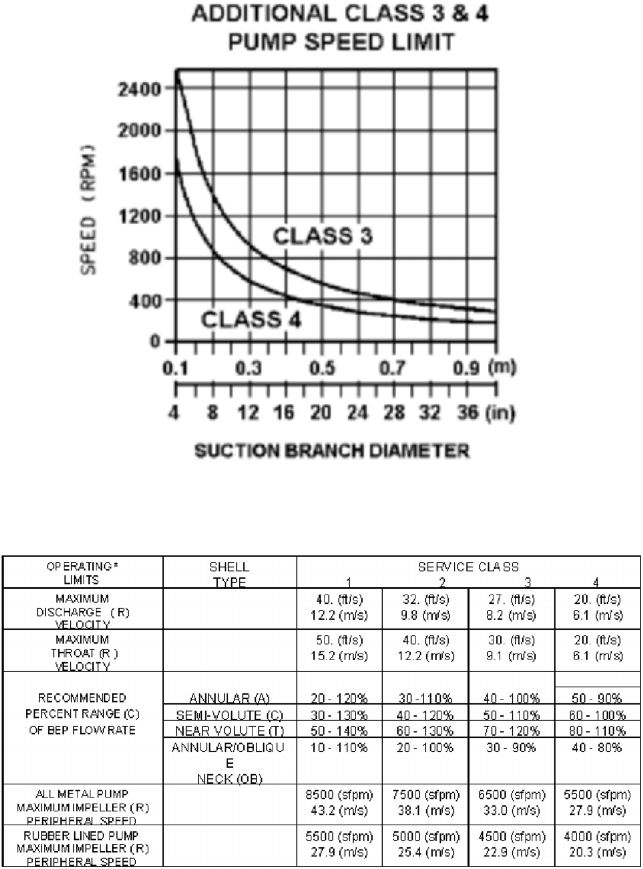
9.16.2 APPLICATION AND CONSTRUCTION OF CENTRIFUGAL SOLIDS HANDLING PUMPS 9.359
FIGURE 10 Pump speed limit chart for classes 3 and 4
[Note: sfpm ft/min; for ft/s, Divide by 60]
TABLE 1 Recommended operating limits for slurry pumps
Except in the case of dredges (which are usually diesel driven), most slurry pumps are
driven by electric motors. Because of the difficulty associated with trimming impeller
diameters and variations of system head, it is common for plant slurry pumps up to 250
hp (185 kW) to have V-belt drives. For larger pumps, four pole motors and gearboxes are
most common, with one or more variable speed units when there are several (usually up
to six) units operating in series.
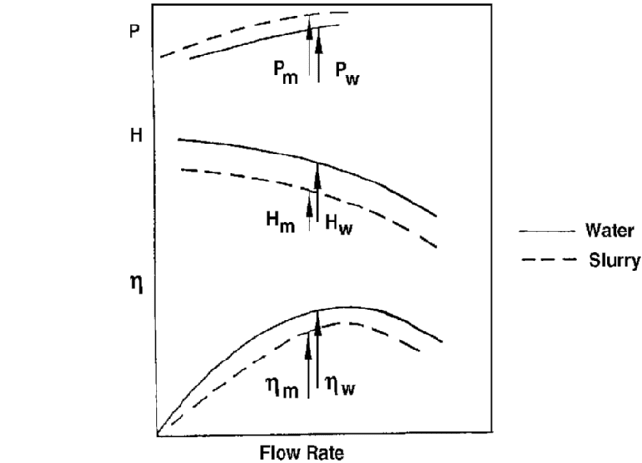
9.360 CHAPTER NINE
FIGURE 11 Effect of slurry on pump characteristics (schematic)
SOLIDS EFFECT ON CENTRIFUGAL PUMPS______________________________
The presence of solid particles in the flow tends to produce adverse effects on pump per-
formance, and detailed information on these effects is needed to achieve reliable and
energy-efficient operation. Head-flow curves for centrifugal pumps are often rather flat.
Also, the pipeline characteristic for slurry flow usually displays a slow rise with increas-
ing discharge.As a result, the two characteristic curves often intercept at a rather shallow
angle. Therefore, even a small diminution in pump head can produce a disproportionately
large drop in flow rate. The resulting difficulties in operation can cause large and expen-
sive systems to run inefficiently or not run at all.
The effects on pump characteristics are shown schematically in Figure 11, which is a
definition sketch for illustrating the reduction in head and efficiency of a centrifugal pump
operating at constant rotary speed and handling a solid-water mixture. In this sketch, and
the discussion that follows, h
m
represents the pump efficiency in slurry service, and h
w
is
the clear-water equivalent. Likewise, P
m
and P
w
are the power requirements for slurry ser-
vice and water service, respectively. The head H
m
is developed in slurry service, measured
in height of slurry, whereas H
w
represents the head developed in water service in height
of water. The head ratio H
r
and the efficiency ratio h
r
are defined as H
m
/H
w
and h
m
/h
w
respectively. The fractional reduction in head (the head reduction factor) is denoted by R
H
and defined as 1 H
r
; for efficiency, the fractional reduction (efficiency reduction factor)
is R
h
, given by 1
—
h
r
.
Test loop results for a large variety of solids at the GIW Hydraulic Testing Laboratory
have been put together in a generalized design diagram (Figure 12) for larger heavy-duty
pumps and smaller pumps having impeller diameters of 8 in (0.2 m) to 16 in (0.4 m). The
diagram gives R
H
and H
r
in terms of pump impeller diameter (D) and solid average size
(d
50
) at a solids concentration by volume (C
v
) of 0.15 (15%) with a solids density ratio 2.65
and a negligible amount of fine particles (X
h
0). For example, a pump with an impeller
diameter of 32 in (0.81 m), R
H
becomes 14% (H
r
0.86) for a d
50
of 0.39 in (10 mm).

9.16.2 APPLICATION AND CONSTRUCTION OF CENTRIFUGAL SOLIDS HANDLING PUMPS 9.361
Corrections for various values of C
v
,S
s
, and X
h
will now be given together with esti-
mations of the reduction in efficiency, R
h
. Based on experimental results discussed in Wil-
son et al. (1997), the R
H
values obtained from Figure 12 may be multiplied by the following
factors when the solids density ratio and the fine particle content are different from 2.65
and zero, respectively.
solids density ratio, S
s
:
fine particlue content, X
h
:
For example, with S
s
4.4 and X
h
0.08 (8%), the factors become 1.6 and 0.85, respec-
tively. The pump previously mentioned with an impeller diameter of 36 in (0.91 m) had R
H
of 14%. This value is now corrected to give
R
H
can normally be related linearly to C
v
, for cases with C
v
less than 15
—
20%. Thus with
C
v
6% in the previous example, R
H
will be 19 (6/15) 8% because the reference value
for C
v
in Figure 12 is 15%.
For the larger pumps in Figure 12, the reduction in efficiency, R
h
, is normally less than
R
H
. For the smaller pumps, with D 6 16 in (0.4 m), R
h
usually equals R
H
; however, it may
be sensitive to solids properties. Independent of the pump type in Figure 12, R
h
may exceed
R
H
if C
v
exceeds about 20%, indicated on Figure 13.
In opposition to these tendencies, there have also been investigations where the reduc-
tion in efficiency remains small at very high concentrations, specifically with broad particle-
size distributions.
R
H
14 11.62 0.85 19%
11 X
h
2
2
c
S
s
1
1.65
d
0.65
FIGURE 12 Effects of particle size (d
50
mm) and impeller diameter (D in) on H
r
and R
H
. For solids concentration
by volume, C = 15% with solids density ratio, S
s
= 2.65 and a negligible amount of fine particles (X
b
= 0). Solid lines
represent smaller newer design pumps while dashed lines represent conventional heavy duty pumps. Adapted from
GIW Industries Inc., U.S.A. [Note: for particle size in inches, multiply by 0.039; for impeller diameters in mm,
multiply inches by 25.4.]
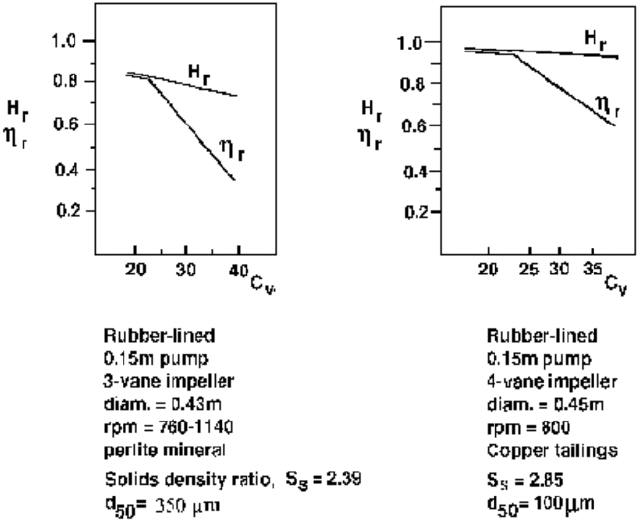
9.362 CHAPTER NINE
FIGURE 13 Head and efficiency reduction curves for two products (from Sellgren and Vappling, 1986). [Note: for
dimensions in inches, divide mm by 25.4 and multiply m by 39.36.]
With equivalent reductions, R
H
R
h
, the power consumption increases directly with
the relative slurry density.
(1)
with R
h
6 R
H
(H
r
7 h
r
), Eq. 1 becomes
that is, the power consumption becomes larger than that given by Eq. 1.
Finally, the calculated reductions may be underestimated if the solid particles are
coarse and very angular. For example, the solids used in the preceding examples consisted
of crushed angular particles and actually gave reductions in head and efficiency well over
10% (Sellgren et al., 1997), compared to R
H
8% calculated here based on Figure 12.
On the other hand, with very fine particles, or large X
h
-values and high solids concen-
trations, most slurries are practically nonsettling. In this case, the solids effect is mainly
related to the rheological behavior. When pumping nonsettling slurries in industrial appli-
cations, the slurry normally behaves in a non-Newtonian way, giving widely varied pump
performance effects. In general, however, small pumps are affected more than large units
when pumping highly viscous or non-Newtonian media. Furthermore, the influence on the
efficiency is normally larger than on the head.
Occasionally, highly non-Newtonian slurries may be pumped by centrifugal pumps
operating at flow rates much lower than the maximum-efficiency value Q
BEP
. This may
cause a dramatic drop in head, which creates an unstable head curve, seen for example in
Figure 14.
P
m
7 S
m
#
P
w
P
m
S
m
#
P
w
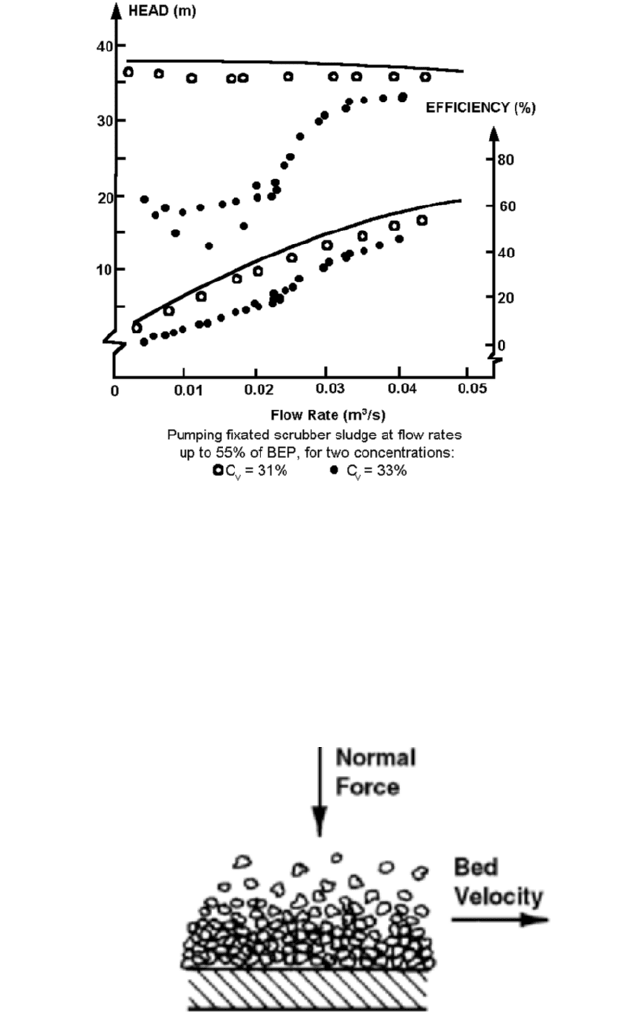
9.16.2 APPLICATION AND CONSTRUCTION OF CENTRIFUGAL SOLIDS HANDLING PUMPS 9.363
FIGURE 14 Effect of highly non-Newtonian slurries on pump head and efficiency (from Sellgren et al., 1997).
[Note: for flow rate in gpm, multiply m
3
/s by 15,850; for head in ft, multiply m by 3.28.]
WEAR MECHANISMS AND MATERIALS __________________________________
As noted earlier, wear in a slurry pump can be severe. It is not possible, therefore, to use
normal cast iron or other materials. Ideally, the life of components should be a year or
more. In practice, even with the best design and materials, it can sometimes be as low as
a month. Understanding wear and using the correct materials is key in the design of a
slurry pump.The major erosive mechanisms are sliding abrasion and particle impact.The
sliding-abrasion mode of wear typically involves a bed of contact-load particles bearing
against a surface and moving tangentially to it, as illustrated on Figure 15. In pipelines,
FIGURE 15 Erosion by sliding abrasion
